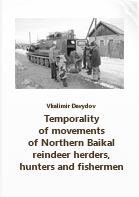Temporality of movements of Northern Baikal reindeer herders, hunters and fishermen
This article addresses the topic of temporality of movement among northern Baikal reindeer herders, hunters, and fishermen. It proposes the distinction between short-term and long-term movements based on the return to places of intensive use. Short-term movements usually do not cover large distances and imply a return to the same place within a relatively short period of time. This type of movement implies the use of one main point where a movement starts and finishes. In contrast to short-term movements, long-term movements require intensive preparation, imply the use of several bases and cover larger distances. They are built upon a set of short-term movements which involve return to certain points of a route from which people operate. Hunting and reindeer herding are not connected only to movement in the taiga; these activities imply the use of stationary and mobile structures and hunting bases. In this context, the village also functions as a kind of base and serves as a point of constant return.

